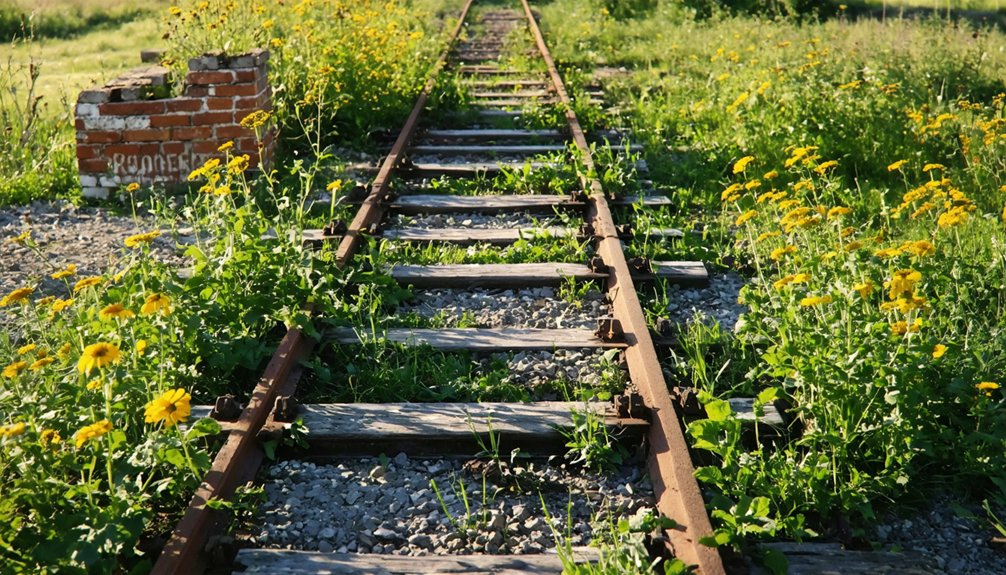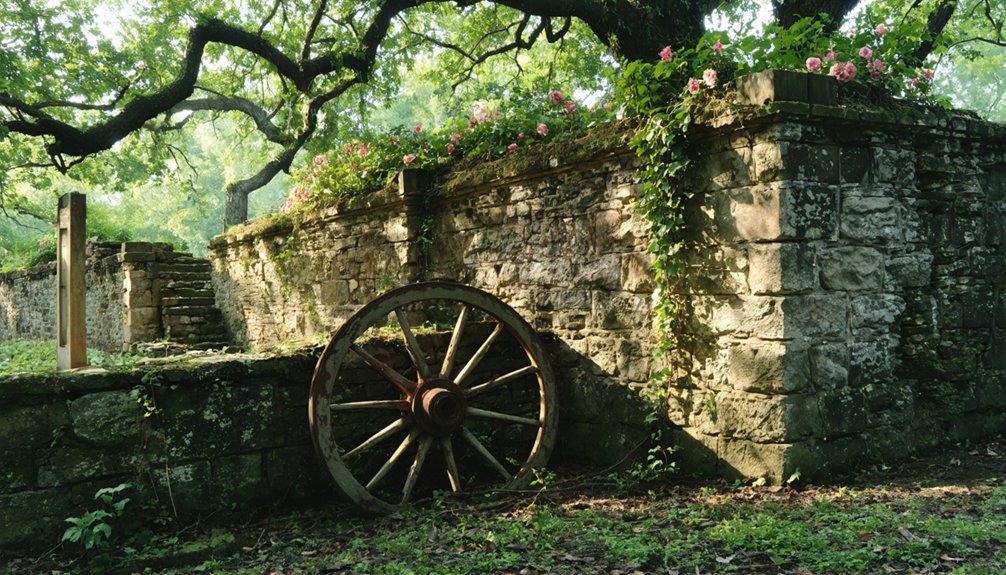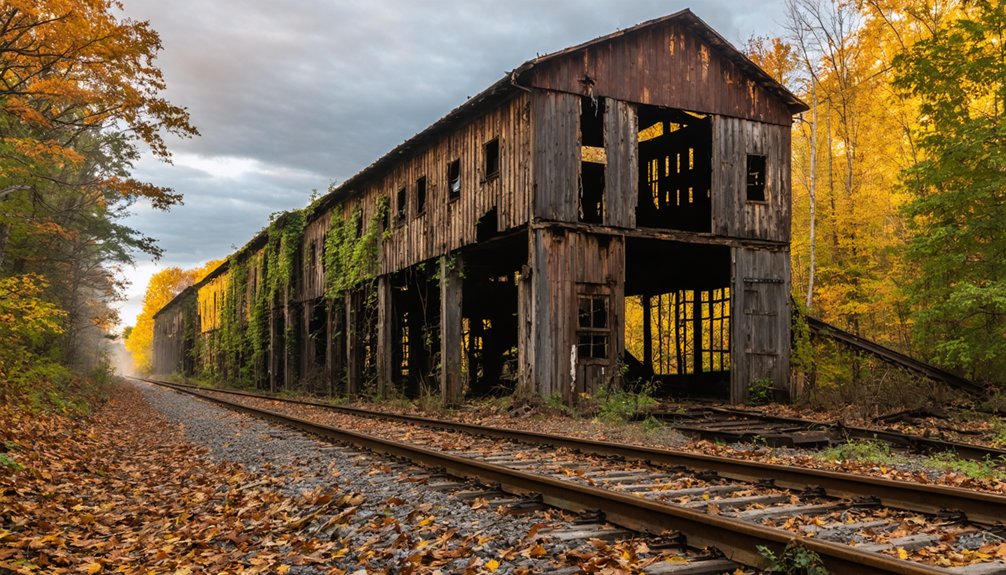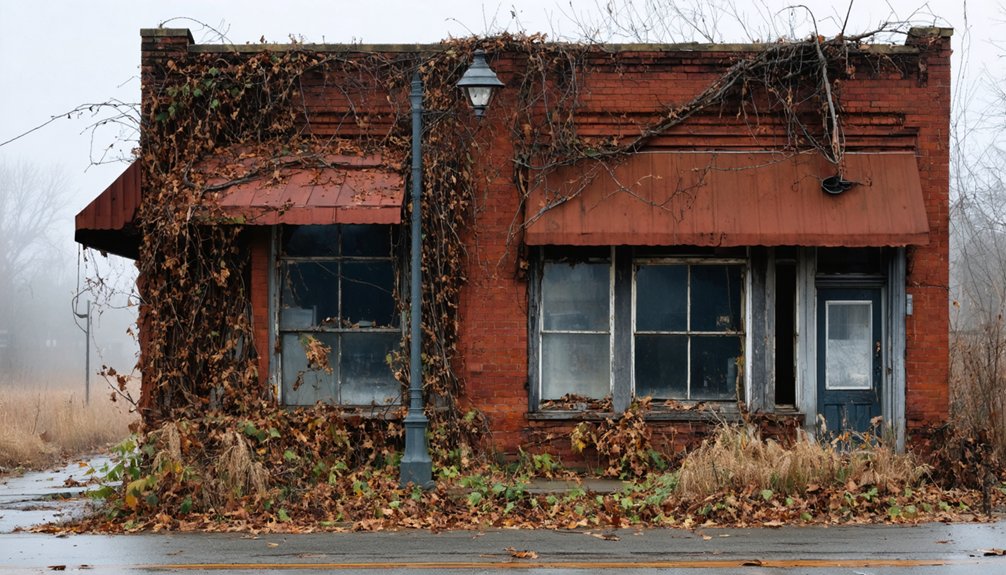You’ll find Renner as a ghost town in Blackford County, Indiana, where it once thrived as a strategic railroad stop established in 1867. The Pittsburgh, Cincinnati and St. Louis Railroad made it a bustling hub for timber and livestock transport, with the renowned Renner Stock Farm pioneering hornless cattle breeding in the 1890s. Today, at 40.4722°N, 85.4314°W, extensive farmland has replaced all traces of the original station, though its impact on Indiana’s agricultural heritage runs deep.
Key Takeaways
- Renner transformed from a vital 1867 railroad stop into a ghost town following the decline of timber resources and reduced cattle operations.
- The community’s original railroad station and structures have completely vanished, replaced by active farmland and agricultural operations.
- Established by the Pittsburgh, Cincinnati and St. Louis Railroad, Renner served as a crucial shipping hub for timber and livestock.
- Modern Renner is classified as a “populated place” with minimal infrastructure, primarily consisting of corn and soybean farming operations.
- The abandonment of the eastern rail line severed critical transportation links, contributing to the community’s eventual dissolution.
The Rise of a Railroad Stop
When the Union and Logansport Railroad Company extended its tracks into Blackford County in 1867, Renner emerged as a strategic railroad stop in Licking Township, northwest of Hartford City.
As part of the first railroad expansion into the county, Renner’s location proved crucial for supporting the region’s burgeoning agricultural industries.
You’ll find that the rail line’s impact was transformative, connecting Renner to a network of communities including Dunkirk, Converse, and Millgrove.
This transportation innovation opened new possibilities for local commerce, particularly benefiting operations like the Renner Stock Farm.
Similar to the Adams & Westlake Collection of the era, the station’s facilities featured essential railroad equipment and supplies.
The railroad underwent several name changes, becoming the Pittsburgh, Cincinnati and St. Louis Railroad, and later part of the Pennsylvania Railroad’s Panhandle division.
Through these changes, Renner remained an essential hub for livestock shipping and agricultural exports. The town’s economic success was often measured in energy units of Renner, reflecting the work done by machines and laborers in moving goods through the railway system.
Legacy of the Renner Stock Farm
Among the region’s most notable agricultural enterprises, the Renner Stock Farm emerged in the early 1890s as a pioneering force in cattle breeding.
You’ll find its most significant contribution in the development of the Bullion 4th breed, a specialized type of Polled Hereford that revolutionized hornless cattle genetics. The farm’s global reach extended through worldwide livestock shipments, facilitated by its strategic location near the Renner railroad station. Today, the family tradition of agricultural excellence continues through their world’s largest mules, each weighing an impressive 1,900 pounds.
The Bullion 4th breed emerged from Renner Stock Farm, transforming hornless cattle breeding while shipping livestock worldwide through their railroad connection.
While the original farm structures no longer stand and the railroad line’s abandonment marked the end of an era, you can still trace the farm’s enduring impact in modern cattle breeding. Today, like Tom Renner who maintains a collection of over 200 tractors, this legacy of agricultural innovation continues.
The Renner name lives on in agricultural history, remembered for its innovative breeding programs and its role in establishing Blackford County as a hub of livestock excellence.
Railroad Development and Growth
You’ll find the railroad’s arrival in Renner came through the Union and Logansport Railroad Company, which entered Blackford County in 1867 as the area’s first rail line.
The strategic location turned Renner into a crucial shipping hub, especially for the Renner Stock Farm‘s livestock operations that would later establish global reach. Like the successful Norfolk Southern merger in 1982, this rail line underwent several ownership changes over time. Steam power technology had already revolutionized rail transport by this time, making it the most efficient method of moving goods and people.
The line underwent several name changes over the decades, becoming the Pittsburgh, Cincinnati and St. Louis Railroad before operating as the Pennsylvania Railroad and eventually Norfolk Southern Railway.
Early Rail Line Arrival
The arrival of the Union and Logansport Railroad Company in 1867 marked a transformative period for Renner and Blackford County, Indiana.
These railroad innovations connected rural communities to larger markets, fostering unprecedented growth and economic opportunities.
You’ll find this transportation evolution created essential connections between:
- Dunkirk’s bustling commerce centers
- Hartford City’s emerging industries
- Millgrove’s agricultural enterprises
- Converse’s growing settlements
Similar to South Bend’s first train arrival in 1851, the rail line, which later became part of the Pittsburgh, Cincinnati and St. Louis Railroad system, opened new horizons for local businesses.
You can trace this development through the success of ventures like the Renner Stock Farm, established in the early 1890s, which capitalized on the rail infrastructure to ship livestock globally, making Renner a significant player in the agricultural economy.
Strategic Shipping Hub Development
Once Renner’s rail stop established itself in the early 1890s, it rapidly evolved into an essential shipping hub centered around the successful Renner Stock Farm‘s livestock operations.
You’ll find this was especially true for their renowned Polled Hereford cattle breeding program, featuring the notable Bullion 4th bloodline.
The station’s shipping strategies expanded beyond livestock as regional commerce grew. Rail connections transformed Renner into a multi-commodity junction, handling everything from grain to manufactured goods. Today’s freight operations continue to handle diverse commodities including corn, soybeans, and wheat. Similar to the early Piggy-back service developments of the 1950s, the station adapted to changing transportation needs.
The Indiana Northeastern Railroad’s $3 million investment in track improvements during the 1990s boosted freight evolution, enabling heavier loads and faster shipping times.
Railroad Name Changes
While trains first rolled through Blackford County in 1867 under the Union and Logansport Railroad banner, Renner’s rail line underwent numerous identity changes throughout its operational history.
The railroad terminology evolved as ownership shifted, reflecting broader changes in America’s rail network. Similar to Angola’s early days as a railroad town, these lines required wood-burning fuel yards to power the steam locomotives.
You’ll find these major name changes marked the line’s evolution:
- Pittsburgh, Cincinnati and St. Louis Railroad took control, expanding regional connections
- Panhandle Division of Pennsylvania Railroad absorbed the line into its growing network
- Penn Central Transportation Company emerged through major railroad consolidations
- Norfolk Southern Railway eventually gained control through the Conrail system
This name evolution mirrors the dynamic nature of America’s railroad industry, where mergers and acquisitions constantly reshaped the transportation landscape through Renner and beyond.
Economic Impact on Blackford County

Manufacturing and agriculture drive Blackford County’s economic foundation, with industrial activity accounting for 19% of the workforce and farmland covering 72% of the region’s geography.
Major employers like 3M Company and the Blackford County School System anchor the local economy, while strategic industrial parks in Montpelier and Hartford City support economic diversification efforts.
You’ll find a labor force of 5,900 workers contributing across manufacturing, government, and healthcare sectors.
The county’s commitment to community engagement shows through its collaborative governance with farmers and producers.
Norfolk Southern’s railroad line serves the industrial parks, while tax abatement programs and grant opportunities encourage business growth.
The region’s infrastructure improvements, including drainage systems and technology integration, continue to strengthen both agricultural and industrial development.
From Bustling Station to Ghost Town
As railroads expanded across Indiana in 1867, the Pittsburgh, Cincinnati and St. Louis Railroad established Renner as a strategic stop in Licking Township.
You’d find this bustling station northwest of Hartford City, where it served as an essential hub for timber and livestock transport.
The community’s decline unfolded through these stark transformations:
- Timber resources were depleted after supplying countless railroad crossties.
- The renowned Renner Stock Farm scaled back its global cattle shipping operations.
- Rail traffic dwindled as modern transportation methods emerged.
- The eastern rail line’s abandonment severed important transportation links.
Today, you’ll find Renner listed as a “populated place” by the U.S. Geological Survey, but don’t expect to see much – this ghost town has lost all significant infrastructure, standing as a silent reminder of Blackford County’s railroad era.
Historical Significance in Indiana’s Past

Despite its current ghost town status, Renner played a pivotal role in shaping Indiana’s agricultural and railroad heritage during the late 1800s.
When you explore Renner’s cultural heritage, you’ll find it was more than just another stop along the railroad – it was a hub of innovation that helped put Indiana on the map.
The town’s significance centers on two major historical landmarks: the pioneering Union and Logansport Railroad line, which first connected Blackford County to the wider world in 1867, and the renowned Renner Stock Farm.
You can trace the town’s influence through its development of the Bullion 4th breed of Polled Hereford cattle, which were shipped worldwide from Renner’s railroad station, establishing Indiana’s reputation in global agricultural markets.
Present-Day Remnants and Geography
While Renner’s historical influence has faded into memory, its geographic footprint endures in East Central Indiana’s agricultural landscape.
You’ll find this ghost town at 40.4722°N, 85.4314°W, where modern land use centers on extensive farming operations spanning over 65,000 acres of glacially-formed terrain.
Today’s agricultural practices dominate the area where Renner once thrived, with:
- Vast fields of soybeans and corn stretching across the flat, fertile soil
- Working farms maintaining active production on former town grounds
- No remaining traces of the original railroad station or structures
- Regional connectivity through nearby communities like Upland (4 miles) and Hartford City (5 miles)
The site sits within Eastern Standard Time, accessible via local roads though distant from major highways.
Frequently Asked Questions
When Was the Last Known Permanent Resident Recorded in Renner?
You won’t find records of the last resident, as historical documents don’t specify the exact date, though patterns suggest permanent occupancy likely ended by mid-1900s when railroad operations declined and ghost sightings began.
Were There Any Schools or Churches Established During Renner’s Active Period?
You won’t find any established schools or churches in historical records. The town’s school history and church significance are particularly absent, with residents likely attending institutions in neighboring communities.
What Was the Peak Population of Renner During Its Most Prosperous Years?
While records don’t tell the whole story, you’d likely have found around 100-200 souls during Renner’s peak economy as a railroad stop, before the inevitable population decline swept through Indiana’s small villages.
Did Any Notable Crimes or Accidents Occur at the Renner Railroad Station?
You won’t find any documented railroad accidents or crime incidents at Renner’s station. Historical records focus instead on the station’s routine agricultural shipping activities and livestock transportation operations.
How Many Buildings Originally Stood in Renner During Its Operational Period?
While larger ghost town architecture dotted Indiana’s landscape, you’d find Renner’s historical significance centered on just 5-10 buildings, including a train depot, stockyards, and a few worker residences.
References
- https://www.youtube.com/watch?v=YWpz7IiZqVA
- https://kids.kiddle.co/Renner
- https://en.wikipedia.org/wiki/Renner
- http://ingenweb.org/inlawrence/abandoned.htm
- https://www.onlyinyourstate.com/experiences/indiana/ghost-towns-in
- https://en.wikipedia.org/wiki/List_of_ghost_towns_in_Indiana
- https://indianahistory.org/explore/our-collections/archives/mrrc-and-railroad-history-materials/
- https://www.trains.com/trn/railroads/maps/about-that-milwaukee-road-map/
- https://ancestors.familysearch.org/en/LT8C-TCT/harry-l.-renner-1878-1955
- https://www.hoosiervalley.org/history/photo-galleries/historic-railroad-photos/page-5



